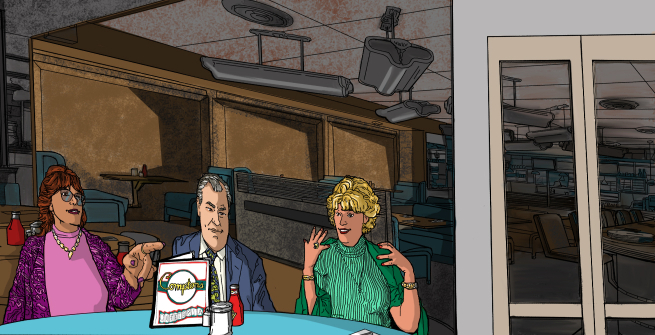Narratives attached to events in LGBTQIA (Lesbian, Gay, Bisexual, Transgender, Queer, Intersex, Asexual) history like the Stonewall riots and other uprisings often de-emphasize the work of transgender people, particularly transgender people of color, in the fight for LGBTQIA rights. Within California, however, the role of transgender women, particularly those of color have thankfully been acknowledged in one of the watershed events in LGBTQIA history, the 1966 Compton’s Cafeteria Riot.
Transgender women have been and continue to be limited in the work they can do and the places they can live openly. In the early 1960s, one of the few places open to transgender people was San Francisco’s Tenderloin district. Located within the Tenderloin, Gene Compton’s Cafeteria (informally known as Compton’s Cafeteria), was a haven for members of the transgender community from the 1940s until its closure in 1972. Open 24 hours, Compton’s served as a space off the streets for transgender people, drag queens, and other gender non-conforming individuals but harassment, improper arrests, and police violence were ongoing issues for LGBTQIA community even within the Tenderloin. Transgender women were often arrested for trivial “crimes” that included “female impersonation” and “obstructing the sidewalk.” Transgender women were regularly harassed, assaulted, and demeaned by the police and the escalating anger at these ongoing abuses finally erupted in the summer of 1966.
Because of discrimination against transgender women and ongoing police brutality, members of the queer community, as part of the culture of political activism endemic of the 1960s, began to organize into political groups to protest the ongoing harassment and advocate for civil rights. In August 1966, a transgender woman was at Compton’s and a police officer harassed her for cross-dressing. She refused to be arrested and a community joined in to protest and began to riot. Within the ensuing chaos, chairs and dishes being tossed and outside, police car windows were broken and a newsstand lit on fire.
The Compton’s Cafeteria Riot, would prove to be a milestone for both the LGBTQIA rights movement and San Francisco’s community history. Following the riot, positive changes began to occur within the Tenderloin and for its transgender community. Continued political activism from the queer community ushered in federal relief through the pathbreaking work of redefining the Tenderloin as a disadvantaged community. This redefining made the area eligible for federal anti-poverty support, such as job training and additional schooling. Allies would help advocate to change laws such as repealing cross-dressing laws in 1974, the formation of the Center for Special Problems, a unit of the San Francisco Department of Public Health that offered some of the nation’s first social services for transgender people, and the creation of the National Transsexual Counseling Unit to create new ID cards for gender non-conforming people.
In 2019, the area around the original Compton’s Cafeteria is now known as Compton's Transgender Cultural District, the first legally recognized transgender district in the world to memorialize the groundbreaking history of the local area.
In honor of Transgender Day of Visibility, the Octavia Lab created a coloring page commemorating the Compton’s Cafeteria Riot and the work of Elliot Blackstone, Aleshia Brevard, and Amanda St. Jaymes.
The Octavia Lab is grateful for the work of Susan Stryker and Victor Silverman in their documentary Screaming Queens in the creation of this coloring page and description. We also acknowledge that policing, being improperly used as a means of control and coercion, remains a major national issue for people of color and especially when it intersects with people who identify as LGBTQIA .
Elliott Blackstone (1924 – 2006) was an ally for the LGBTQIA community and a sergeant for the San Francisco Police Department. In 1962, he, as a pioneer of community policing, became the department’s liaison for the LGBTQIA community. He worked within the police department to change how LGBTQIA was policed by changing department policies and procedures.
Amanda St Jaymes (dates unknown) was a hotel manager and present at the Compton’s Cafeteria Riot. Her eyewitness description of the event and the community helped bring light to the path-changing work happening in the Tenderloin during the late 1960s into the 1970s.
Aleshia Brevard (1937 – 2017) was an author, model, actress, and professor of theater. Aleshia lived and worked in the Tenderloin during the period preceding the Compton’s Cafeteria Riot. Brevard began transitioning to a woman in the early 1960s and after transition, lived a fulfilling life, not identifying as part of the transgender community until writing her memoirs.
—Special thanks to Vi Ha, Nicholas Beyelia and Julie Huffman.
 You can download and print out the complete coloring page here.
You can download and print out the complete coloring page here.

















